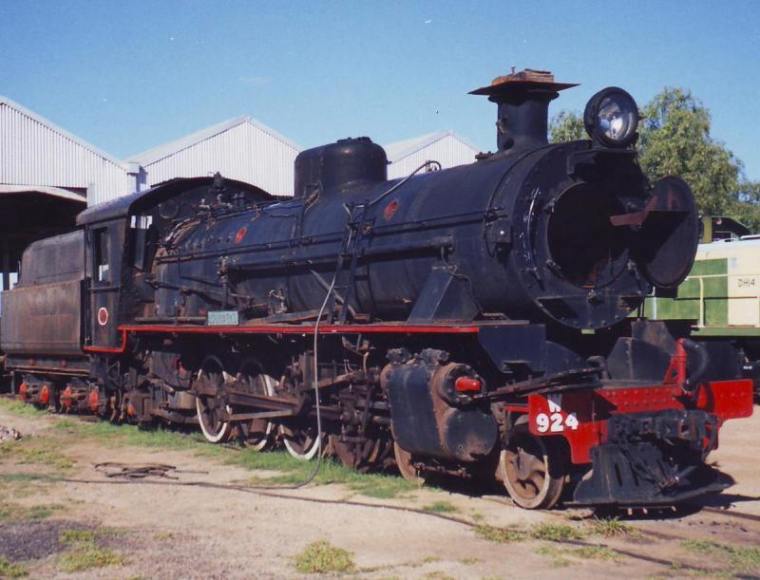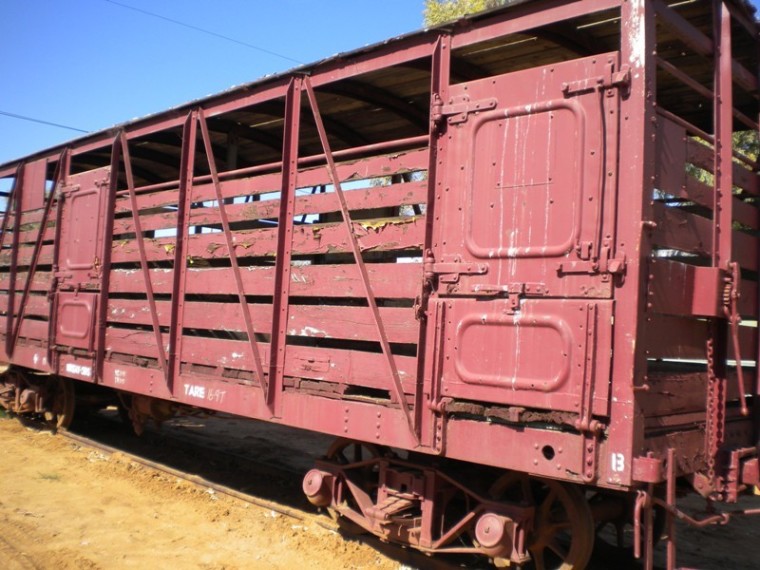
General Douglas MacArthur arrival in Australia began with his railway journey - the brief back-story is explaining the three different rail gauges (widths between the tracks) used in Australia.
In the 1940s, different states used one or more of three different gauges for a variety of political, economic and historical reasons. South Australia used all three. They were narrow gauge (3ft 6ins or 1067 mm), broad gauge (5'3" or 1600 mm) and standard gauge (4' 8.5" or 1435 mm).
Since the 1990s, most of the long distance trains have been converted to standard gauge, so passengers can now traverse the country more conveniently. But this isn't universal, and there are still some areas where the gauges vary, for one practical reason or another.
Importance of "break of gauge" towns.
So, you can imagine that, in previous eras, at places where a rail gauge from one system met a rail gauge from another system, the trains had to stop because one train could not magically adjust its wheels and run on a track of different width.
Therefore, everything from one train had to be transferred to another train for the onward journey. This included passengers and their luggage of course, but also livestock, coal, grain, food, heavy mining equipment, and, particularly during the War, military supplies and equipment.
This could take up to 20 hours for livestock or equipment. Passenger trains usually accomplished the changeover more quickly, but my parents tell stories of having to change trains at Albury in the middle of the night, where the NSW standard gauge met the Victorian broad gauge. They remember having to carry their heavy bags all the way along a very long platform (450 metres, or in thos days, 1,480 ft). There were no wheelie-bags or light weigh backpacks, just large, solid suit-cases.
In fact, the transfer of military personnel and equipment at Albury was somewhat of a hindrance to the War effort. Russell Drysdale's famous painting depicts what would have been a typical scene of soldiers waiting, huddled in their great-coats.
General MacArthur's arrival in Australia
In March 1942, General MacArthur was ordered by President Roosevelt to leave the Philippines before it was overrun by the Japanese invaders. He and his wife, his son and some of their staff journeyed through Japanese-controlled waters by Torpedo Boats (PT boats – perhaps best remembered by J F Kennedy's wartime exploits, and then in the 60s and 70s by the American wartime sitcom, "McHale's Navy").
His party got safely to Darwin, then flew on to Alice Springs in a DC3 aircraft. Legend has it that his wife had such a terrible flight, that she refused to fly in this aircraft again, so they boarded the old Ghan (narrow gauge train) of the Commonwealth Railways to continue their journey to Adelaide, then on to Melbourne and later Brisbane where he was to oversee the Allied war effort in the South Pacific; and much later, the occupation and rehabilitation of Japan.
The South Australia's train to Adelaide was broad gauge; the Ghan he had been on was narrow gauge. The first to be established in South Australia, originally to facilitate the transportation of wool from the north and east to Port Adelaide on broad gauge and grain to Port Pirie on narrow gauge. That town is Terowie.
Who has ever heard of Terowie?
The reporters in Adelaide in 1942 knew all about Terowie. It was a thriving town of about 2000 from 1880s through to the war years, when the population increased even more due to a military base nearby. It was a railway town, with staff employed in ensuring the safe and efficient transfer of all those goods (and passengers) from one train to another.
It had trains travelling east west and from Silverton and Broken Hill down to the coast to smelters for processing the ore. This was a very busy railway junction between 1910 and 1920 with over 100 trains per day. They say it still holds the world record for the number of trains passing through a region on a single track system.
Having eschewed the plane from Alice Springs, General Douglas MacArthur travelled by train on the rickety 3'6" gauge line over two nights, finally arriving in Terowie on the 20 March 1942.
The news reporters from Adelaide all knew that the family had to change trains, and everyone knew his schedule. General Douglas MacArthur gave what is now referred to as a "door stop interview" and made his famous speech which included the phrase: "I came out of Bataan and I shall return".
This said first in Terowie, South Australia. MacArthur subsequently repeated the line "I shall return" in a number of other speeches, in a number of other places. The event is commemorated by a plaque on the now disused railway platform.
Terowie is 20 km south of Peterborough which did become the central railway hub in 1969, when the standard gauge track was built west to Port Augusta. Terowie was bypassed, and its population dropped suddenly. Many of the old rails were even removed to be used in new lines being built.
Today, Terowie is a tourist town with a population at best of around 200 people with many historic railway memorabilia on show and plenty of history illustrating what the town was like in its historic heyday where the freight was transhipped from one gauge wagons to another, back and forth. It has a number of well-preserved 1880s buildings, and has been declared a "historic town".
Being a little more than 200 km north of Adelaide, it belongs in the Council of Goyder, named after the famous surveyor who established the "Goyder line", demarkating the areas that are too dry to grow wheat. My almost-brush with fame is that, in my high school days in Canberra, our family home was in Goyder Street, Narrabundah Heights.
The Footplate Padre says that history describes many situations where there are similar local differences on an overall theme. Missions are the classic example. Perhaps one day there will be a "standard gauge" and Christians will heed
1 Corinthians 1 verse 10"Now I beseech you, brethren, by the name of our Lord Jesus Christ, that ye all speak the same thing, and that there be no divisions among you; but that ye be perfectly joined together in the same mind and in the same judgement."


Dr Mark Tronson - a 4 min video
Chairman – Well-Being Australia
Baptist Minister 45 years
- 1984 - Australian cricket team chaplain 17 years (Ret)
- 2001 - Life After Cricket (18 years Ret)
- 2009 - Olympic Ministry Medal – presented by Carl Lewis
- 2019 - The Gutenberg - (ARPA Christian Media premier award)
Gutenberg video - 2min 14sec
Married to Delma for 45 years with 4 children and 6 grand children